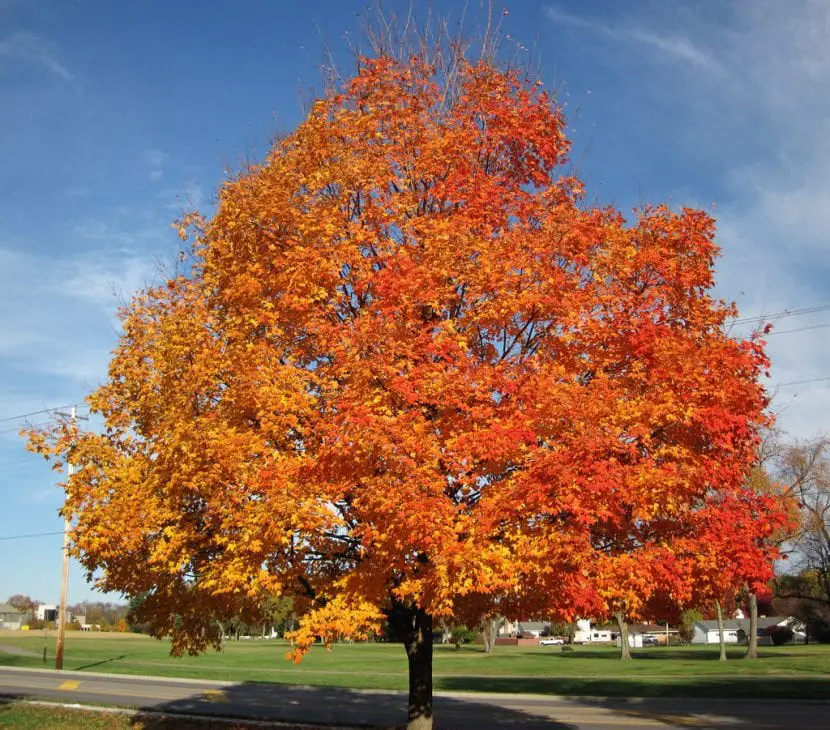
Acer
The maple tree It is one of the most striking: its webbed leaves are very decorative throughout the year, but especially in autumn when they change color, turning red, orange, yellow or purple.
In addition, gives an excellent shadewhich is ideal for enjoying the outdoors in the hottest months. So if you want a beautiful plant that is easy to find in nurseries and relatively easy to care for, this may be the tree you are looking for. Why? For everything that we are going to tell you now.
Maple Characteristics

Pennsylvania maple
The term maple, or maple in English, it refers to the 160 accepted species of the 600 that have been described belonging to the botanical family Sapindaceae, subfamily Hippocastanoideae. these amazing plants are mainly native to the temperate regions of the Northern Hemispherefound in North America (United States and Canada), Europe and Southeast Asia. In Spain they grow naturally in the mountain ranges of the Iberian Peninsula, and you can find some sharp opal in the Sierra de Tramuntana (north of the island of Mallorca).
How is the maple leaf?
They are characterized by having opposite leaves, which are usually palmately lobed in most speciesbut there are also some that have them that are pinnately compound, palmately compounded, pinnately veined, and without lobes. They are expired, except those of the species Evergreen steelwhich can be perennial or semi-perennial. In addition, they often have magnificent autumn colors: red, orange, yellow, reddish purple; for this reason, maples are very decorative plants.
How is the fruit of the maple?
They are dioecious plants, that is, there are male feet and female feet. The flowers, which bloom in late winter or early spring, appear grouped in inflorescences in the form of a cluster, corymb or umbel. If they are pollinated, the fruits will begin to ripen, which are called samaras double or bi-samara which, when released, rotate moved by the wind.
These are characterized by having two seeds with a wing each that are joined by one side of what is the seed itself. The wing is fragile in the sense that it breaks easily with the hands, although they feel harder than, for example, paper or leaves.
What uses does it have?

Pennsylvania maple
Our protagonist grown primarily as an ornamental plant and for shade. There are many species that grow to heights of 10 meters or more, such as the Acer pseudoplatanus (30 meters), the Acer platanoides (25-35 meters), or the Acer rubrum (20-30 meters), among others. The branches often grow more or less horizontal, so that the tree is adopting an oval or parasol shape.
But it also has other uses: wood is used to make musical instrumentsy with the sap of Acer maple syrup is produced. Additionally, the maple leaf is a national symbol in Canada, and is depicted on its flag. And of course, it is very worked like bonsai.
How do you take care of yourself?

Acer platanoides
Having one of these trees in the garden is wonderful; However, in order for it to be perfectly healthy, it is very important that the following care is provided:
- Location: it must be outside, in semi-shade.
- Land: It must be fresh, loose, rich in organic matter and with good drainage. Most prefer acid soils, with a pH between 4 and 6, but there are some such as Acer saccharum, Acer campestre or acer opalus -one of the maples that we have in Spain- that can grow well in slightly limestone soils.
- Irrigation: very frequent, especially in summer. Generally, it will be watered three to four times a week in summer, and every 3-4 days the rest of the year.
- Subscriber: for it to grow better, it is advisable to fertilize it in spring and summer with organic powder fertilizers, such as chicken manure (if it is fresh, let it dry in the sun for at least a week to prevent the roots from burning), or goat manure once a month. Another option is to pay with guano that you can buy here!.
- Pruning: it can be pruned at the end of winter, before the budding of the leaves. Dry, weak and diseased branches have to be removed, and it can also be used to shape it.
- Planting time: in spring, before the leaves sprout.
- Multiplication: by seeds, stratifying them in the refrigerator for three months and sowing them in the seedbed in spring, by cuttings in autumn or late winter, and by air layering in spring. Cultivars are multiplied by grafting.
- Rusticity: It depends on the species, but they usually withstand temperatures of -15ºC well. In case of doubt, ask us.
What are the most representative species?
To finish, we leave you with some photos of the most representative maple tree species:

